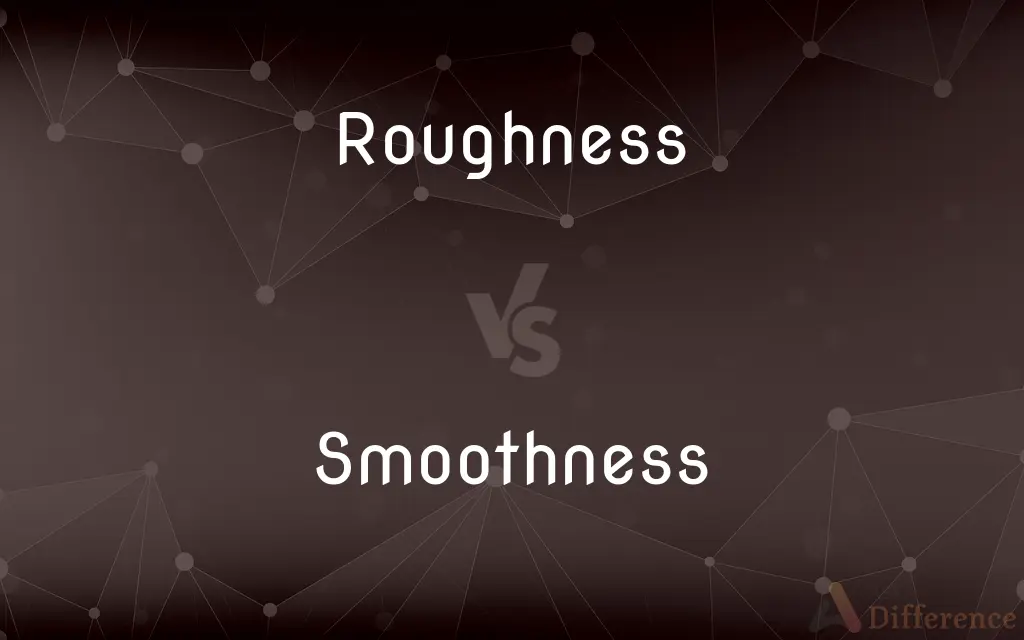Roughness vs. Smoothness — What's the Difference?
By Maham Liaqat & Urooj Arif — Updated on March 27, 2024
Roughness refers to a surface's uneven or coarse texture, while smoothness indicates a flat, even surface free of irregularities.

Difference Between Roughness and Smoothness
Table of Contents
ADVERTISEMENT
Key Differences
Roughness characterizes surfaces with irregularities and textures that can be felt physically or seen visually, whereas smoothness describes surfaces that are even and regular, providing a tactile sense of continuity without interruption. These properties are essential in various fields, from material science to product design, where they influence functionality and aesthetics.
While rough surfaces can increase friction, providing better grip or reducing reflectivity, smooth surfaces are often sought after for their low resistance, ease of cleaning, and pleasing tactile qualities. The distinction between roughness and smoothness plays a critical role in applications such as automotive design, where both characteristics are optimized for performance and user experience.
In manufacturing and engineering, the measurement of roughness is critical for ensuring parts fit together correctly and function as intended. On the other hand, smoothness measurements are vital in industries like optics, where surface irregularities can significantly impact the performance of lenses and mirrors.
The perception of roughness and smoothness can also vary depending on the scale and context. A surface that feels smooth to the touch may appear rough under a microscope, highlighting the relative nature of these concepts. Whereas, the standard for smoothness in one application may differ greatly in another, reflecting the subjective assessment of these qualities.
Textures described as rough or smooth have significant implications for product design, influencing not only the aesthetic appeal but also the functionality and user experience. For example, the choice between a rough or smooth finish on a smartphone case affects both its grip and its visual appeal to consumers.
ADVERTISEMENT
Comparison Chart
Definition
Texture with irregularities and coarse features
Even, regular surface free of irregularities
Influence on
Friction and grip
Resistance and ease of cleaning
Measurement importance
In manufacturing for fit and function
In optics for performance
Perception
Can vary with scale; tactile and visual
Consistent at a tactile level; may vary visually
Implications in design
Affects functionality and aesthetics
Influences aesthetics and user experience
Compare with Definitions
Roughness
Texture with irregularities.
The roughness of the sandpaper makes it ideal for smoothing wood surfaces.
Smoothness
Quality of being easy to clean.
The smoothness of the kitchen countertop simplifies cleaning.
Roughness
Visual and tactile aspect.
The roughness of the painting added a dynamic texture that enhanced its appearance.
Smoothness
Characteristic of being even and uniform.
The smoothness of the lake at dawn was like a mirror.
Roughness
Surface not smooth to the touch.
The roughness of the old road caused the ride to be bumpy.
Smoothness
Reflective of low resistance.
The smoothness of the car’s finish reduces air resistance, improving efficiency.
Roughness
Characteristic of being coarse.
The roughness of his hands was a testament to years of hard labor.
Smoothness
Lack of surface irregularities.
The smoothness of the marble made it cool and pleasant to the touch.
Roughness
Measurement of surface unevenness.
Engineers assess the roughness of metal surfaces to ensure proper lubrication.
Smoothness
Perceived visually and by touch.
The smoothness of the fabric made the dress particularly appealing.
Roughness
Having a surface marked by irregularities, protuberances, or ridges; not smooth
Planed the board so it was no longer rough.
Smoothness
In mathematical analysis, the smoothness of a function is a property measured by the number of continuous derivatives it has over some domain. At the very minimum, a function could be considered smooth if it is differentiable everywhere (hence continuous).
Roughness
Coarse or shaggy to the touch
A rough scratchy blanket.
Smoothness
Having a surface free from irregularities, roughness, or projections; even.
Roughness
Difficult to travel over or through
The rough terrain of the highlands.
Smoothness
Free from waves or disturbances; calm
The lake is smooth today.
Roughness
Characterized by violent motion; turbulent
Rough waters.
Smoothness
Free from hair, whiskers, or stubble
Felt his smooth cheek after the close shave.
Roughness
Difficult to endure or live through, especially because of harsh or inclement weather
A rough winter.
Smoothness
Having a short dense flat coat. Used of dogs.
Roughness
Unpleasant or difficult
Had a rough time during the exam.
Smoothness
Having a fine texture
A smooth fabric.
Roughness
Characterized by or done with violence or forcefulness
A sport noted for rough play.
A package that received rough handling.
Smoothness
Having an even consistency
A smooth pudding.
Roughness
Boisterous, disorderly, or given to violence
Ran with a rough crowd.
Smoothness
Having an even or gentle motion or movement
A smooth ride.
Roughness
Characterized by violence or crime
Lives in a rough neighborhood.
Smoothness
Having no obstructions or difficulties
A smooth operation.
A smooth trip.
Roughness
Lacking polish or finesse
Rough manners.
Smoothness
Easy-going; serene
A smooth temperament.
Roughness
Harsh to the ear
A rough raspy sound.
Smoothness
Not sharp or bitter in taste
A smooth wine.
Roughness
Being in a natural state
Rough diamonds.
Smoothness
Delicately pleasing to the ear; not harsh or grating
A smooth voice.
Roughness
Not perfected, completed, or fully detailed
A rough drawing.
Rough carpentry.
Smoothness
Ingratiatingly polite and agreeable
Known for his smooth remarks.
Roughness
The surface or part of something that is uneven or coarse
Felt the rough of his chin.
Smoothness
To make (something) even, level, or unwrinkled
Smoothed the fabric with an iron.
Roughness
Rugged overgrown terrain.
Smoothness
To rid of obstructions, hindrances, or difficulties
A real estate agent who smoothed the process of applying for a mortgage.
Roughness
(Sports) The area of a golf hole in which the grass is left unmowed or is cut to a length longer than that of the fairway.
Smoothness
To soothe or tranquilize; make calm
The president tried to smooth over the hurt feelings of the disputing factions.
Roughness
A disorderly, unrefined, or unfinished state.
Smoothness
To cause to appear less harsh or severe than is the case
Don't try to smooth over their faults.
Roughness
A difficult or disagreeable aspect or condition of something
Observed politics in the rough when working as an intern on Capitol Hill.
Smoothness
To become smooth.
Roughness
A person given to violent or disorderly behavior; a rowdy.
Smoothness
The act of smoothing.
Roughness
To treat roughly or with physical violence
Roughed up his opponent.
Smoothness
A smooth surface or part.
Roughness
(Sports) To treat (an opposing player) with unnecessary roughness, often in violation of the rules
Was ejected from the game for roughing the passer.
Smoothness
The condition of being smooth; the degree or measure of said condition.
Roughness
To prepare or indicate in an unfinished form
Rough out a house plan.
Smoothness
The highest order of derivative (the differentiability class) over a given domain.
Smoothness can vary from 0 (for a nondifferentiable function) to infinity (for a smooth function).
Roughness
In a rough manner; roughly
The engine began to run rough and faltered.
Smoothness
The quantity measured by the modulus of smoothness.
Roughness
The property of being rough, coarseness.
The roughness of the road made me wonder if my car would fall apart.
Smoothness
Quality or state of being smooth.
Roughness
Something that is rough; a rough spot.
Smoothness
A texture without roughness; smooth to the touch
Roughness
(US) Roughage; coarse fodder.
Smoothness
The quality of being free from errors or interruptions
Roughness
(Scotland) Abundance, especially of food.
Roughness
A measure of how rough something is, such as a surface
The surface roughness was low.
Roughness
The quality or state of being rough.
Roughness
A texture that is not smooth but is irregular and uneven
Roughness
Harsh or rough to the ear
Roughness
An unpolished unrefined quality;
The crudeness of frontier dwellings depressed her
Roughness
Used of the sea
Roughness
Rowdy behavior
Roughness
The formation of small pits in a surface as a consequence of corrosion
Common Curiosities
Why is smoothness preferred in optics?
In optics, smoothness is essential as surface irregularities can degrade the performance of lenses and mirrors.
How do you measure roughness and smoothness?
Roughness and smoothness are measured with specialized instruments that assess surface texture and irregularities.
How does texture influence product design?
Texture, whether rough or smooth, influences product design by affecting aesthetics, functionality, and user experience.
Are there standards for measuring roughness?
Yes, there are industry-specific standards and instruments for measuring roughness to ensure material and product quality.
What defines roughness in a material?
Roughness is defined by a material's surface irregularities and texture that can be tactile or visible.
Is roughness always undesirable?
No, roughness can be desirable for increased grip, reduced reflectivity, and other functional or aesthetic purposes.
Why is roughness important in manufacturing?
Roughness is crucial for ensuring parts fit correctly, function as intended, and provide necessary friction.
Can the smoothness of a surface affect its functionality?
Yes, the smoothness of a surface can influence its resistance, cleaning ease, and overall performance in various applications.
How is smoothness achieved in materials?
Smoothness is achieved through processes like polishing, sanding, or coating to create an even and uniform surface.
Can a surface be both rough and smooth?
A surface may appear smooth at a macro level but show roughness under closer inspection, indicating the scale-dependent nature of these properties.
What role does perception play in assessing roughness and smoothness?
Perception plays a significant role, as individuals may differently interpret the tactile and visual cues of surface texture.
How does smoothness impact cleaning?
Smooth surfaces are generally easier to clean because they lack the crevices where dirt and bacteria can accumulate.
Can technology control surface texture?
Advanced manufacturing techniques can precisely control the texture of a surface, tailoring its roughness or smoothness for specific applications.
How does roughness affect friction?
Roughness can increase friction by creating more contact points on a surface, which can be beneficial for grip and traction.
Does the environment affect the roughness or smoothness of a surface?
Environmental factors like wear, abrasion, and erosion can alter the roughness or smoothness of a surface over time.
Share Your Discovery

Previous Comparison
Faith vs. Trust
Next Comparison
Holiday vs. LeaveAuthor Spotlight
Written by
Maham LiaqatCo-written by
Urooj ArifUrooj is a skilled content writer at Ask Difference, known for her exceptional ability to simplify complex topics into engaging and informative content. With a passion for research and a flair for clear, concise writing, she consistently delivers articles that resonate with our diverse audience.














































